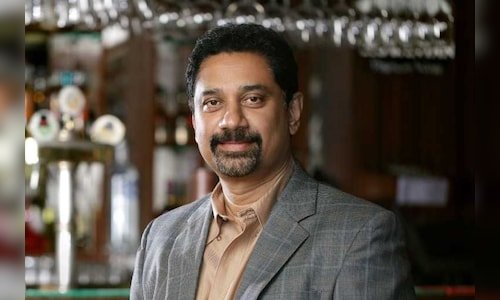India must safeguard Indian products in FTA deals, says John Distilleries chairman | Q&A

Established in 1996, John Distilleries Ltd is today a leading alcobev company known for its flagship brand Original Choice. Exported to over 44 nations, John Distilleries’ Paul John Single Malts is one of the largest-selling premium liquor in India and one of the most awarded Indian Single Malts globally with over 320 international awards. Recently, Sazerac Company, the largest family-owned spirits firm in the US, became a significant stakeholder in Bengaluru-based John Distilleries.
In a free-wheeling discussion with Timsy Jaipuria, John Distilleries’ Chairman Paul P John spoke about taxation challenges and growth prospects.
Edited excerpts:
Tell us how it started and how has John Distilleries’ journey been.
When John Distilleries was established in 1996 our mass brand – Original Choice – was already a leading consumer brand, especially in Karnataka. Over the years, we took the brand to other southern states. In 2012, we launched Paul John Indian single malts in the UK. The single malts were introduced in India in 2014 and now we are available across 22 states, 44 countries and various national and international duty-free stores.
We expanded our portfolio of offerings to include premium wines, whisky, brandy and gin. Our drive is to ensure we cater to every requirement across every segment and category. The growth of our malts shows a 25% average year-on-year growth across markets, while Original Choice has been hitting record sales over the past few years.
What are the challenges in the Indian liquor market and what kind of government support is the industry looking for?
The Indian liquor market is widely fragmented. The duties and taxes as well as the route to market vary greatly from state to state and the entry barriers are also different in each market.
As an industry, we too hope for what every industry wants — standard taxation, a transparent route to market and the ease of doing business to ensure a level playing field. However, this will continue to be difficult as long as alcohol remains a state subject.
How should the state governments address the liquor industry’s concerns on excise and taxation?
Liquor is a significant revenue generator for state governments, and it is unrealistic to expect them to forgo the substantial taxation and other benefits they derive from this industry.
However, we would like the states to recognise us as an industry and extend similar benefits as those provided to other sectors. It is important to ensure ease of doing business, with transparent processes in place for permissions, approvals, streamlining operations, the freedom of pricing, higher access points in each state, experience stores, etc.
With single malt brands flooding the market, is it a matter of concern when it comes to their quality? What kind of regulations does the industry need?
Competition is always healthy for any category, and more single malt brands offer more variety and a larger range of experiences to consumers.
Quality is an issue that the industry needs to address with stringent standardisation. Since there is no clarity on guidelines and regulations today, it is easy for anyone to label a product as a single malt without necessarily meeting the required parameters.
We need clear guidelines for what can be called Indian single malt, and these definitely need to include the origin of the grain, the process by which it is fermented and distilled, and the minimum duration of ageing.
You have a single malt distillery in Goa you are expanding… Please share details and how you think this is going to help the company’s growth.
With the demand for our malts rising over the years we have recently invested in trebling our production capacity from 1.3 million litres to over 3 million litres annually, besides increasing our storage facilities.
We are investing around ₹100 crore in this expansion. In the long run, this will ensure that we are able to meet the domestic market and export demands.
I believe you are the only one in the country to have a visitors’ centre — a kind of museum for liquor connoisseurs — at your Goa distillery. What was the idea behind having such a unique place in Goa?
Our Visitor Centre has served well to educate consumers on the intricate journey that leads to the making of fine malts. It is fair to say that before we got into Indian single malts, single malt whisky was more of a hobbyist category with no single standard product being offered across the country to all consumers.
As part of our effort to establish the Indian single malt category, we recognised the need for consumers to fully understand and experience the product—from malting, distilling, and fermenting to manufacturing and, ultimately, tasting it first-hand. With our single malt distillery located in Goa, it made sense to establish the visitor centre there, especially when Goa is a choice destination for the world.
What are your other expansion plans? What kind of new offerings can we expect from John Distilleries?
From a manufacturing standpoint, we remain open to opportunities but will only expand in areas that align with our strategic goals and category-creation efforts.
We will continue to release special editions of our single malts and premium product lines while expanding mass-market offerings. This includes introducing new variants and expressions of Roulette in whisky, gin, vodka, rum, etc. We will also selectively incorporate special products from the Sazerac international portfolio to develop American whisky as an important category in India.
You are the leading exporter of premium products today… Which markets are popular for Indian products? What are the challenges when it comes to exports?
Growth in Asian markets has been healthy, especially in the past couple of years, and we expect this to steadily do well, especially in South Korea, Taiwan, Japan and Singapore. In certain states in the US and in countries like the UK, there is a demand for Indian products. However, we feel that the Indian single malt as a category is still in a nascent stage in overseas markets.
For the product to do well, the category itself needs to grow. A large percentage of consumers are still unaware of Indian single malts and reaching out and educating them is the main challenge we face in exports.
There is a lot of buzz around FTAs. India has signed one with Australia, while FTAs with the UK and EU are in the pipeline. How is this going to help Indian players and what caution does the government need to take while signing these FTAs?
Most luxury products from around the world are already available in India. The FTAs will mainly benefit mid-range, mass-market products by helping them establish a presence here, and in some cases, they will facilitate the entry of smaller, niche products.
The government already provides benefits to these low-volume international products, and nearly every state has regulations that favour imported brands while disadvantaging Indian products. The government must ensure a level playing field when signing FTAs so that world-class Indian products are not disadvantaged in the domestic market.
Once this bias is eliminated, the Indian luxury alcoholic beverages industry will see accelerated growth within India and internationally. These FTAs should allow India to offer world-class products at competitive prices globally and open new avenues for the Indian alcohol beverages industry if done correctly by the government.








